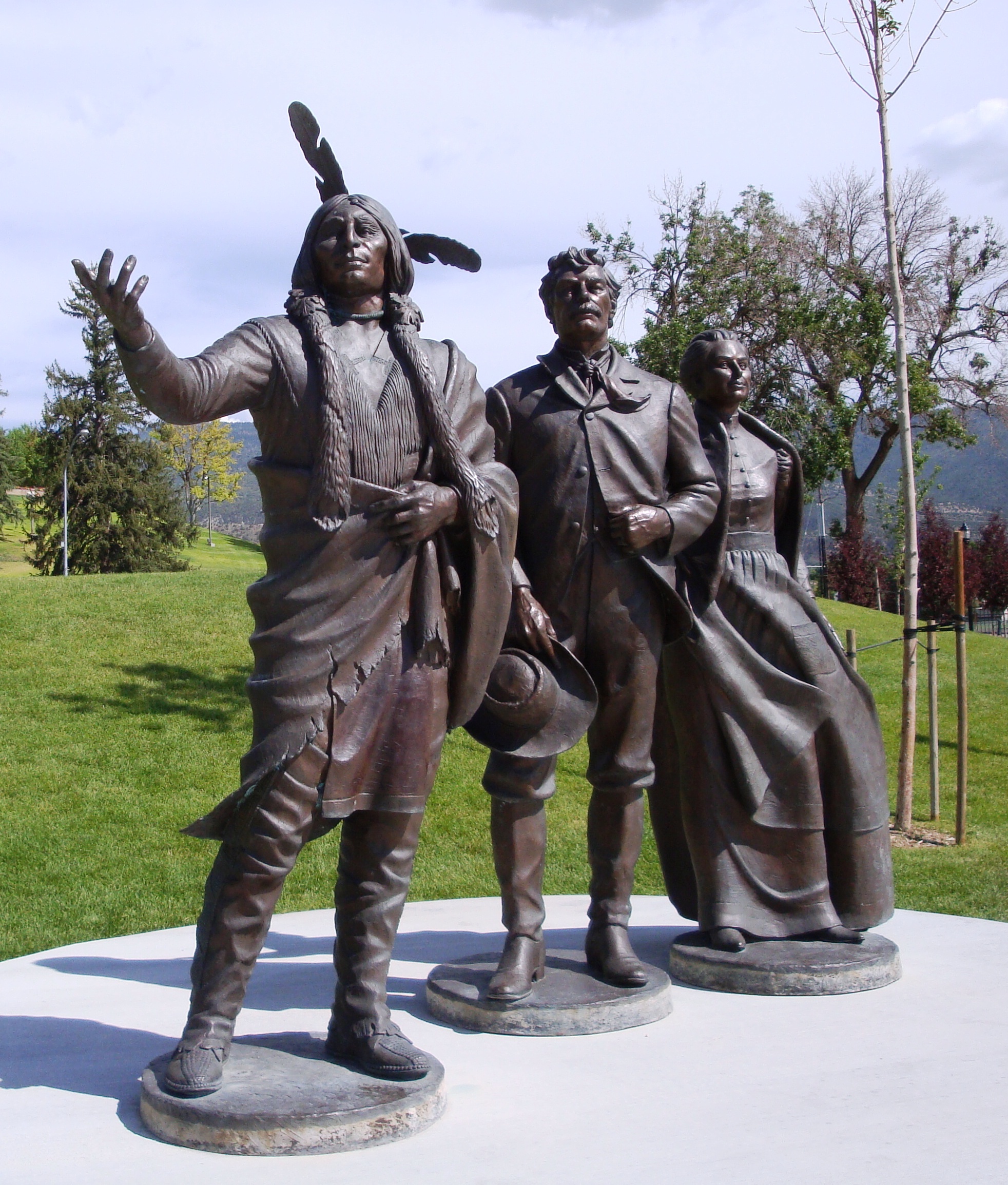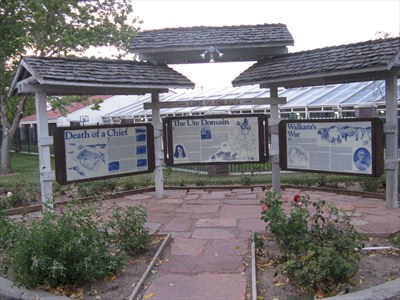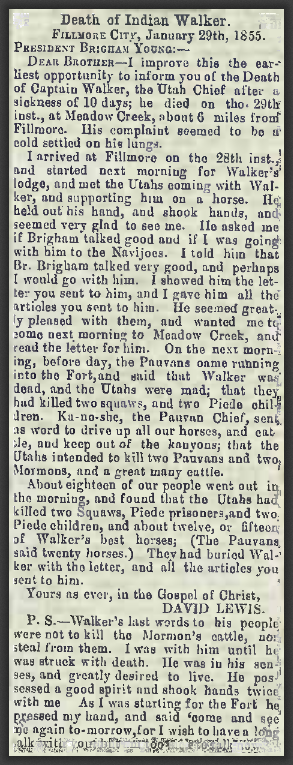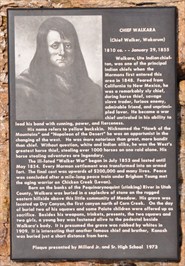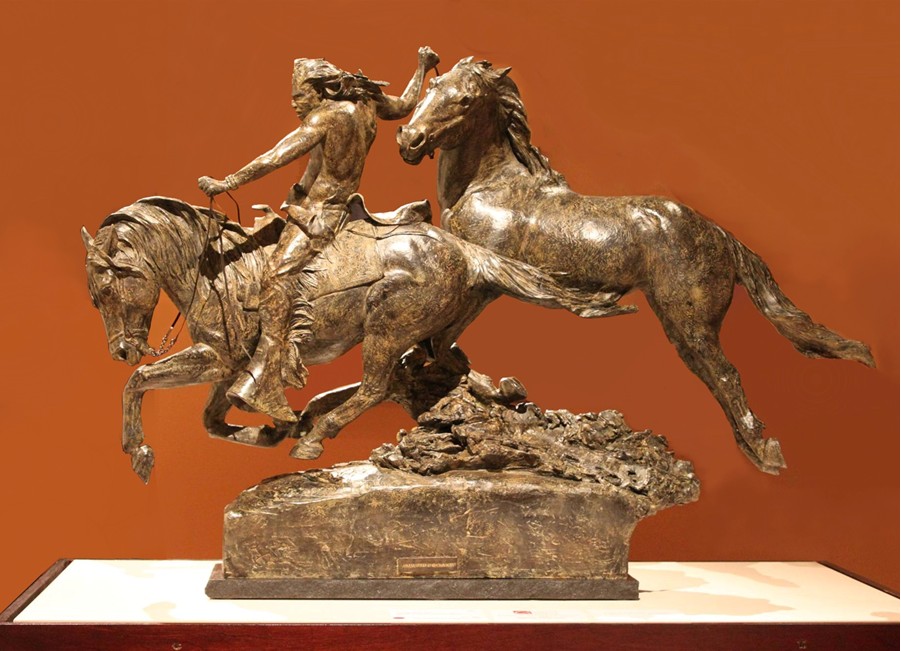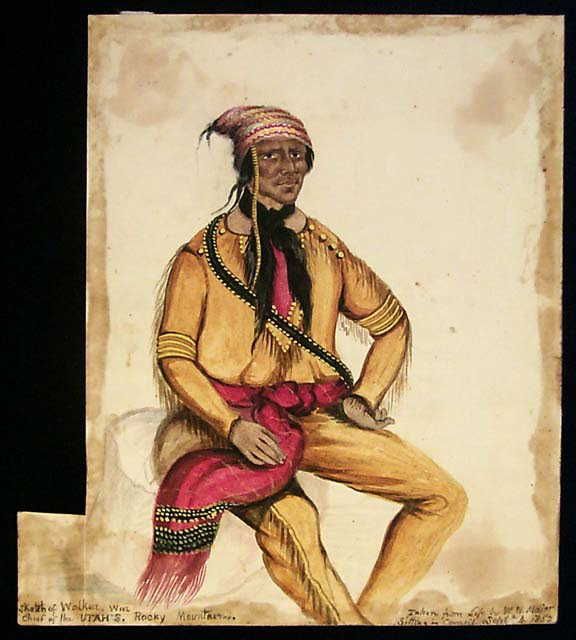Chief Walkara, aka Yah-keera, aka Walker, aka Colorow [no referral to Chief Colorow, who died in December 1888, - Yampah Utes, White River Band, Native American Northern Utes]
Chief Walkara, or Chief Walker, was also known by many other alises: In-carree-keera, Wacca, Wakeera, Iron Twister, Keeper of the Yellow Metal, and was born about 1800. Walkara is considered the correct spelling; as American Indian names were spelled phonetically, there are many variations.
The Shoshoni name, Walkara, means "Hawk". He was one of, at least, eight sons of a chief of the Timpanogo Ute Indian Band, named Moonch. They were known as warriors of the Great Basin Tribe, raised in the region along what is now known as the Spanish Fork River in Utah. Nicknamed "Hawk of the Mountains" and "Napoleon of the Deseret", he became one of the West's leading War Chiefs.
His birth name was Pan-a-Carre Quinker (Iron Twister), but he maintained that, in a vision he received on "Medicine Rock", after the tragic death of his first love and her unborn child, he was renamed.....by "Towats", the Great Spirit. He was to be called Ya-Keerah, "Keeper of the Yellow Metal". This was in reference of his inherited guardianship of the Ute Nation's gold, contained in the High Uinta Mountains of Utah.
In the 1820's he and other Ute leaders established trade relations with intruding fur trappers from Europe, Canada and the east coast of America. They formed alliances with the foremost mountain men traveling the Old Spanish Trail from New Mexico to California. The chiefs were successful in demanding "tribute" or bounty from others crossing Ute land.
He and his brothers, including the famed Chief Arapeen, for whom the Arapeen Valley near Sterling, Utah was named, gathered warriors from various tribes, including Paiutes, Utes, Shoshone and others, forming raiding parties which brought them great wealth.
Chief San-Pitch, Chief Kanosh, and Sowiette were legendary brothers of Walkara, as was Tabiona, Ammon, and Grospeen. By the early 1840's Walkara was reputedly the principle ruling chief of this region. In addition to mastering the alphabet of Indian Sign Language, he was known to be fluent in many native dialects and could speak both Spanish and English, which gave him great influence as a cunning trader. Native bands paid bounty to him in return for his protection and influence with other tribes.
His friends and brothers knew him as a highly principled man who provided well for his family. He created a well organized cavalry, which was successful in raiding and capturing large numbers of horses, the most famous being a campaign in 1840 through the Cajon Pass into southern California. It is said that they acquired up to 3000 head of horses, mainly stolen from Spaniards, including Cahuilla leader, Juan Antonio.
The entire Great Basin was his stomping ground and his people took pride in his reputation as both a savvy diplomat and a great horse thief. The Cajon Pass, in California, has two canyons named for his prosperous exploits - Horse Thief Canyon and Little Horse Thief Canyon!
Chief Walkara was recognized by his use of bright yellow buckskin leathers and yellow face paint, which he used during these raids, and was sometimes called "Man of Gold" and "Keeper of Yellow Metal". His followers were often bedecked with metal ornaments and brightly dyed materials.
Walkara was initially friendly to the Latter-day Saint pioneers who, in 1848, began to settle in the Great Salt Lake Valley. He admired their presiding leader, Brigham Young, and invited the "Mormon" colonists to settle the "San-Pitch Valley" near present day Manti, Utah. It would later be known as Sanpete Valley.
It is legend that the original gold adorning the statue of Moroni and other architecture of the Salt Lake City LDS Temple was donated by Chief Walkara, as a sign of his admiration for the Mormon Prophet.
Walkara was reported to have been the first "Lamanite" to have been baptized a Christian in the Salt Lake Valley. On March 13, 1850, Manti Bishop, Isaac Morley, baptized Walkara a member of the LDS Church. A bronze statue of Morley and his wife, along with Chief Walkara, stands on the grounds of Pioneer Heritage Gardens Park in Manti. In the background stands the L.D.S.Temple.
Trade relations were mutual between Walkara and President Young. Soon, his lifestyle of raiding was threatened by expanding settlement and pressure from federal troops, originally sent west to keep an eye on the Mormons because of their religious practices. Walkara had also enjoyed a profitable slave trade in his raids on lesser tribes and this did not set well with the Mormons, who held beliefs based on each individual's right to freedom.
A report published in the Deseret News July 12, 1850, titled "Indian Fight" is an example of some of the Chief's tactics when disputes arose:
July 1st. we received a long letter from John W. Jones, Capt. of the Oquawka, (Ill.) co. of emigrants, giving the particulars of an Indian fight, at yellow creek, about eleven miles west of Bear River, on the morning of the 27th of June. We have not room for the particulars, but the principal facts have since been corroborated by Mr. A. Williams of Utah, who says that the Utah Chief, Walker, told him that he had burned six lodges of the Snakes, eleven miles west of Bear River; killed seven men, and four squaws; and taken five prisoners, and forty horses in revenge for the Snakes having previously killed some of his Indians. While the captors were contending about the division, they killed all the horses. The prisoners were for sale. Walker's Statement is doubtless correct, and agrees with Capt. Jones, except in length and particulars. The supposed Fight, near Weber, the following day, we think a mistake, for the above.
Tension erupted into what is known as The Walker War. In July of 1853 settlers in the area of Springfield, Utah Valley and several Shoshone band members committed mutual hostilities and confrontations resulted in several deaths. By May of 1854, The Walker War ended through negotiations between Brigham Young and Chief Walkara.
In his contemporary work, "Incidents of Travel and Adventure in the Far West" (1857), photographer and artist Solomon N. Carvalho gives account of the council held between Walkara, other native leaders, and President Young. Carvalho persuaded Chief Walkara to pose for a portrait, now held by the Thomas Gilcrease Institute, Tulsa, Oklahoma.
Walkara died, supposedly of pneumonia, 29 January 1855 at Meadow Creek, Millard County, Utah. Purportedly, at his funeral, fifteen horses, two favorite wives, and two of his children were killed and buried along with him. Since he had several wives and several supposed "concubines", it is impossible to identify which wives and children were killed and which were spared from the ritual.
Elder Isaac Morley, his long time friend, had promised Walkara to speak at the entombment [interment is burial in the ground - entombment is encasement within an existing cave or opening]. Morley later described the terrible ordeal and reported that he dare not object to the ceremony for fear of causing an uprising in the already delicate relationship between Walkara's brothers and the white settlers.
In addition, two living Piede slave children were said to be sealed inside the tomb to keep "watch" over Walkara and his treasures. Their mournful crying was meant to scare away animals and possible enemies, until the spirits of the departed had three days to make their journey to "Towats". These were considered savage customs, which repulsed civilized inhabitants, causing a rift between local settlers and Walkara's brothers.
According to the "Utah State Burials Data Base, Markers and Monuments": Chief Walkara was born on the banks of the Pequinarynoquint (Stinking) River in Utah County. He was "buried in a sepulcher of stone on the rugged eastern cliff side above the community of Meadow". His grave was located up Dry Canyon, the first canyon north of Corn Creek. It is presumed the grave was robbed in 1909.
A monument, with a picture of him and an engraved metal plaque upon a 5' X 5' Lava Rock Boulder, was placed in 1973 at 335 North Main Street in Meadow, Millard, Utah. Another Utah State Monument at 50 West Capitol Avenue in Fillmore, Millard, Utah is a large roofed kiosk with pictures, maps and photographs, known as "The Land of the Yuta Markers". It features a plaque dedicated to Chief Walkara, describing his burial in the talus slope overlooking the western desert above Meadow.
It was reported that the original grave site was indeed robbed in 1909; but pioneers claimed that, in April of 1856, his frozen remains were secreted off and buried by his brother, Chief Arapeen, who had succeeded Walkara as reigning chief of the Utes and his half brother, Tabiona (Chief Tabby), along with five other Utes and two Mormon Elders.
The secret site was said to be high in the Uinta Mountains, at a location known as Carre-Shinob. Here Walkara's remains were supposedly placed to repose with those of his paternal grandfather and many ancestors. Legend has it that the site is also a repository of much Uinta gold from Indian mines.
Chief Walkara, aka Yah-keera, aka Walker, aka Colorow [no referral to Chief Colorow, who died in December 1888, - Yampah Utes, White River Band, Native American Northern Utes]
Chief Walkara, or Chief Walker, was also known by many other alises: In-carree-keera, Wacca, Wakeera, Iron Twister, Keeper of the Yellow Metal, and was born about 1800. Walkara is considered the correct spelling; as American Indian names were spelled phonetically, there are many variations.
The Shoshoni name, Walkara, means "Hawk". He was one of, at least, eight sons of a chief of the Timpanogo Ute Indian Band, named Moonch. They were known as warriors of the Great Basin Tribe, raised in the region along what is now known as the Spanish Fork River in Utah. Nicknamed "Hawk of the Mountains" and "Napoleon of the Deseret", he became one of the West's leading War Chiefs.
His birth name was Pan-a-Carre Quinker (Iron Twister), but he maintained that, in a vision he received on "Medicine Rock", after the tragic death of his first love and her unborn child, he was renamed.....by "Towats", the Great Spirit. He was to be called Ya-Keerah, "Keeper of the Yellow Metal". This was in reference of his inherited guardianship of the Ute Nation's gold, contained in the High Uinta Mountains of Utah.
In the 1820's he and other Ute leaders established trade relations with intruding fur trappers from Europe, Canada and the east coast of America. They formed alliances with the foremost mountain men traveling the Old Spanish Trail from New Mexico to California. The chiefs were successful in demanding "tribute" or bounty from others crossing Ute land.
He and his brothers, including the famed Chief Arapeen, for whom the Arapeen Valley near Sterling, Utah was named, gathered warriors from various tribes, including Paiutes, Utes, Shoshone and others, forming raiding parties which brought them great wealth.
Chief San-Pitch, Chief Kanosh, and Sowiette were legendary brothers of Walkara, as was Tabiona, Ammon, and Grospeen. By the early 1840's Walkara was reputedly the principle ruling chief of this region. In addition to mastering the alphabet of Indian Sign Language, he was known to be fluent in many native dialects and could speak both Spanish and English, which gave him great influence as a cunning trader. Native bands paid bounty to him in return for his protection and influence with other tribes.
His friends and brothers knew him as a highly principled man who provided well for his family. He created a well organized cavalry, which was successful in raiding and capturing large numbers of horses, the most famous being a campaign in 1840 through the Cajon Pass into southern California. It is said that they acquired up to 3000 head of horses, mainly stolen from Spaniards, including Cahuilla leader, Juan Antonio.
The entire Great Basin was his stomping ground and his people took pride in his reputation as both a savvy diplomat and a great horse thief. The Cajon Pass, in California, has two canyons named for his prosperous exploits - Horse Thief Canyon and Little Horse Thief Canyon!
Chief Walkara was recognized by his use of bright yellow buckskin leathers and yellow face paint, which he used during these raids, and was sometimes called "Man of Gold" and "Keeper of Yellow Metal". His followers were often bedecked with metal ornaments and brightly dyed materials.
Walkara was initially friendly to the Latter-day Saint pioneers who, in 1848, began to settle in the Great Salt Lake Valley. He admired their presiding leader, Brigham Young, and invited the "Mormon" colonists to settle the "San-Pitch Valley" near present day Manti, Utah. It would later be known as Sanpete Valley.
It is legend that the original gold adorning the statue of Moroni and other architecture of the Salt Lake City LDS Temple was donated by Chief Walkara, as a sign of his admiration for the Mormon Prophet.
Walkara was reported to have been the first "Lamanite" to have been baptized a Christian in the Salt Lake Valley. On March 13, 1850, Manti Bishop, Isaac Morley, baptized Walkara a member of the LDS Church. A bronze statue of Morley and his wife, along with Chief Walkara, stands on the grounds of Pioneer Heritage Gardens Park in Manti. In the background stands the L.D.S.Temple.
Trade relations were mutual between Walkara and President Young. Soon, his lifestyle of raiding was threatened by expanding settlement and pressure from federal troops, originally sent west to keep an eye on the Mormons because of their religious practices. Walkara had also enjoyed a profitable slave trade in his raids on lesser tribes and this did not set well with the Mormons, who held beliefs based on each individual's right to freedom.
A report published in the Deseret News July 12, 1850, titled "Indian Fight" is an example of some of the Chief's tactics when disputes arose:
July 1st. we received a long letter from John W. Jones, Capt. of the Oquawka, (Ill.) co. of emigrants, giving the particulars of an Indian fight, at yellow creek, about eleven miles west of Bear River, on the morning of the 27th of June. We have not room for the particulars, but the principal facts have since been corroborated by Mr. A. Williams of Utah, who says that the Utah Chief, Walker, told him that he had burned six lodges of the Snakes, eleven miles west of Bear River; killed seven men, and four squaws; and taken five prisoners, and forty horses in revenge for the Snakes having previously killed some of his Indians. While the captors were contending about the division, they killed all the horses. The prisoners were for sale. Walker's Statement is doubtless correct, and agrees with Capt. Jones, except in length and particulars. The supposed Fight, near Weber, the following day, we think a mistake, for the above.
Tension erupted into what is known as The Walker War. In July of 1853 settlers in the area of Springfield, Utah Valley and several Shoshone band members committed mutual hostilities and confrontations resulted in several deaths. By May of 1854, The Walker War ended through negotiations between Brigham Young and Chief Walkara.
In his contemporary work, "Incidents of Travel and Adventure in the Far West" (1857), photographer and artist Solomon N. Carvalho gives account of the council held between Walkara, other native leaders, and President Young. Carvalho persuaded Chief Walkara to pose for a portrait, now held by the Thomas Gilcrease Institute, Tulsa, Oklahoma.
Walkara died, supposedly of pneumonia, 29 January 1855 at Meadow Creek, Millard County, Utah. Purportedly, at his funeral, fifteen horses, two favorite wives, and two of his children were killed and buried along with him. Since he had several wives and several supposed "concubines", it is impossible to identify which wives and children were killed and which were spared from the ritual.
Elder Isaac Morley, his long time friend, had promised Walkara to speak at the entombment [interment is burial in the ground - entombment is encasement within an existing cave or opening]. Morley later described the terrible ordeal and reported that he dare not object to the ceremony for fear of causing an uprising in the already delicate relationship between Walkara's brothers and the white settlers.
In addition, two living Piede slave children were said to be sealed inside the tomb to keep "watch" over Walkara and his treasures. Their mournful crying was meant to scare away animals and possible enemies, until the spirits of the departed had three days to make their journey to "Towats". These were considered savage customs, which repulsed civilized inhabitants, causing a rift between local settlers and Walkara's brothers.
According to the "Utah State Burials Data Base, Markers and Monuments": Chief Walkara was born on the banks of the Pequinarynoquint (Stinking) River in Utah County. He was "buried in a sepulcher of stone on the rugged eastern cliff side above the community of Meadow". His grave was located up Dry Canyon, the first canyon north of Corn Creek. It is presumed the grave was robbed in 1909.
A monument, with a picture of him and an engraved metal plaque upon a 5' X 5' Lava Rock Boulder, was placed in 1973 at 335 North Main Street in Meadow, Millard, Utah. Another Utah State Monument at 50 West Capitol Avenue in Fillmore, Millard, Utah is a large roofed kiosk with pictures, maps and photographs, known as "The Land of the Yuta Markers". It features a plaque dedicated to Chief Walkara, describing his burial in the talus slope overlooking the western desert above Meadow.
It was reported that the original grave site was indeed robbed in 1909; but pioneers claimed that, in April of 1856, his frozen remains were secreted off and buried by his brother, Chief Arapeen, who had succeeded Walkara as reigning chief of the Utes and his half brother, Tabiona (Chief Tabby), along with five other Utes and two Mormon Elders.
The secret site was said to be high in the Uinta Mountains, at a location known as Carre-Shinob. Here Walkara's remains were supposedly placed to repose with those of his paternal grandfather and many ancestors. Legend has it that the site is also a repository of much Uinta gold from Indian mines.
Family Members
Advertisement
Advertisement



